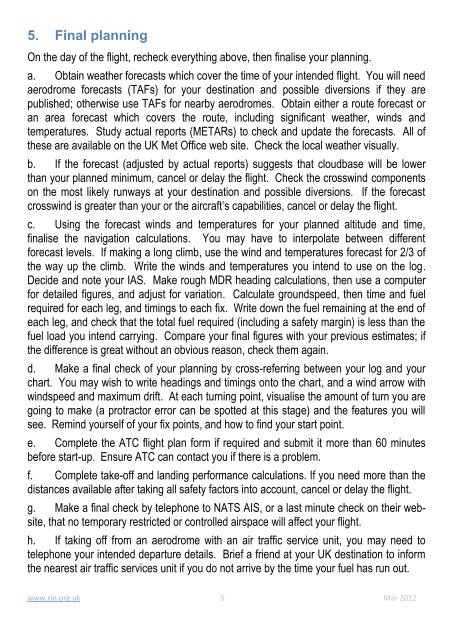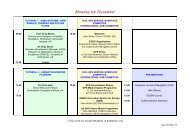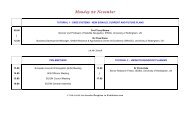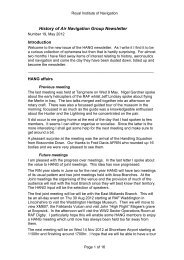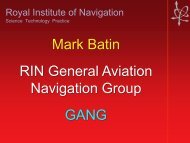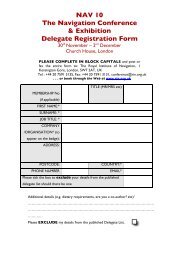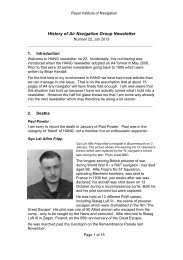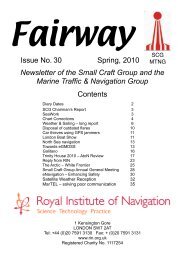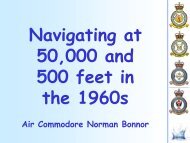VFR Guide - Royal Institute of Navigation
VFR Guide - Royal Institute of Navigation
VFR Guide - Royal Institute of Navigation
You also want an ePaper? Increase the reach of your titles
YUMPU automatically turns print PDFs into web optimized ePapers that Google loves.
5. Final planning<br />
On the day <strong>of</strong> the flight, recheck everything above, then finalise your planning.<br />
a. Obtain weather forecasts which cover the time <strong>of</strong> your intended flight. You will need<br />
aerodrome forecasts (TAFs) for your destination and possible diversions if they are<br />
published; otherwise use TAFs for nearby aerodromes. Obtain either a route forecast or<br />
an area forecast which covers the route, including significant weather, winds and<br />
temperatures. Study actual reports (METARs) to check and update the forecasts. All <strong>of</strong><br />
these are available on the UK Met Office web site. Check the local weather visually.<br />
b. If the forecast (adjusted by actual reports) suggests that cloudbase will be lower<br />
than your planned minimum, cancel or delay the flight. Check the crosswind components<br />
on the most likely runways at your destination and possible diversions. If the forecast<br />
crosswind is greater than your or the aircraft‟s capabilities, cancel or delay the flight.<br />
c. Using the forecast winds and temperatures for your planned altitude and time,<br />
finalise the navigation calculations. You may have to interpolate between different<br />
forecast levels. If making a long climb, use the wind and temperatures forecast for 2/3 <strong>of</strong><br />
the way up the climb. Write the winds and temperatures you intend to use on the log.<br />
Decide and note your IAS. Make rough MDR heading calculations, then use a computer<br />
for detailed figures, and adjust for variation. Calculate groundspeed, then time and fuel<br />
required for each leg, and timings to each fix. Write down the fuel remaining at the end <strong>of</strong><br />
each leg, and check that the total fuel required (including a safety margin) is less than the<br />
fuel load you intend carrying. Compare your final figures with your previous estimates; if<br />
the difference is great without an obvious reason, check them again.<br />
d. Make a final check <strong>of</strong> your planning by cross-referring between your log and your<br />
chart. You may wish to write headings and timings onto the chart, and a wind arrow with<br />
windspeed and maximum drift. At each turning point, visualise the amount <strong>of</strong> turn you are<br />
going to make (a protractor error can be spotted at this stage) and the features you will<br />
see. Remind yourself <strong>of</strong> your fix points, and how to find your start point.<br />
e. Complete the ATC flight plan form if required and submit it more than 60 minutes<br />
before start-up. Ensure ATC can contact you if there is a problem.<br />
f. Complete take-<strong>of</strong>f and landing performance calculations. If you need more than the<br />
distances available after taking all safety factors into account, cancel or delay the flight.<br />
g. Make a final check by telephone to NATS AIS, or a last minute check on their website,<br />
that no temporary restricted or controlled airspace will affect your flight.<br />
h. If taking <strong>of</strong>f from an aerodrome with an air traffic service unit, you may need to<br />
telephone your intended departure details. Brief a friend at your UK destination to inform<br />
the nearest air traffic services unit if you do not arrive by the time your fuel has run out.<br />
www.rin.org.uk 5 Mar 2012


